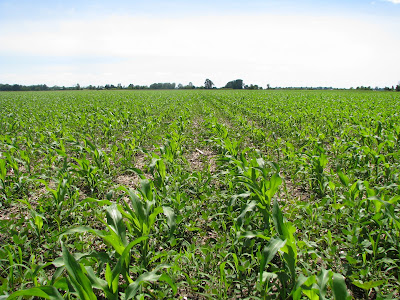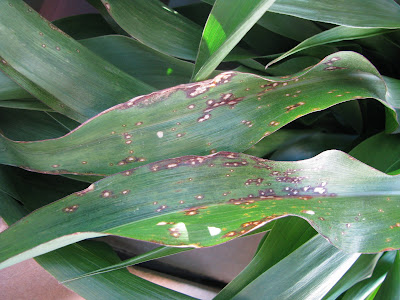DON'T GIVE WEEDS THE UPPER HAND

I cringe every year when I see weed pressures like that above robbing growers of precious yield.To optimize the yield performance of corn it is Critical to keep Weeds out of it between the 3 - 8 leaf stage.

Roundup Ready Corn was developed to give growers crop safety and more options to control tough to kill weeds.Unfortunately the fact that Glyphosate can be sprayed on large corn without any deleterious crop injury has lulled too many growers into a false sense of security.

Yes large weeds can be controlled by late glyphosate applications and by the time harvest rolls around you can think you were a genious by how clean your crop is BUT the fact remains that yield was lost.Though the weeds in the above photo have been controlled they were left too long and they will have hurt this crops yield performance.DON'T LET THIS HAPPEN TO YOU !

The highest yielding weed control system that can be employed is to spray two applications of glyphosate on glyphosate resistant corn.The first spray application should be made at the 3 true leaf stage and the second at the 7 true leaf stage.Why anyone would leave this kind of weed pressure to impact their crops performance is beyond my comprehension.
Growers who feel that this could put too much reliance on the use of Glyphosate can achieve the next highest yield performance with a pre-emerge spray application followed by an in crop application of glyphosate at the 5 - 6 leaf stage if needed.

Another option that can be successfully used by growers is to spray Glyphosate at the 3 true leaf stage and lay down a grass or broadleaf tank mix residual at the same time.

Whatever you do please try to avoid letting weeds getting an upper hand.

Glyphosate resistant corn is a wonderful technology but its got to be used properly in order to maximize yields.
 Mid to late April plantings are just fine provided soils are suitably fit for planting.
Mid to late April plantings are just fine provided soils are suitably fit for planting. The unfortunate part is that there may be areas in large 60-70 acre fields that are not fit.
The unfortunate part is that there may be areas in large 60-70 acre fields that are not fit. When you proceed to plant these areas anyway you run the risk of creating subtle compactive zones in the soil profile.Sidewall smearing can become a real issue in restricting early season root development as well as lower seedtrench compaction which will restrict a young seedlings roots from penetrating to lower soil depths.
When you proceed to plant these areas anyway you run the risk of creating subtle compactive zones in the soil profile.Sidewall smearing can become a real issue in restricting early season root development as well as lower seedtrench compaction which will restrict a young seedlings roots from penetrating to lower soil depths. The result is a lack of even crop development.Certain tight areas may exhibit yellow due to slow N nitification or slower seedling root development.Other even tighter areas may exhibit N denitrification due to cooler and pastier soil conditions.These tighter soil condition areas will also be slower to drain when any rainfall event occurs.You must be cognizant of the fact that the roots of young corn seedlings will not grow into cool,moist pasty soil conditions.They will produce as many lateral roots as they can until soils dry enough that they can grow deeper.The unfortunate part of this is that any soil restrictions impeding lateral root development will stall out a young corn crop hurting its yield potential.
The result is a lack of even crop development.Certain tight areas may exhibit yellow due to slow N nitification or slower seedling root development.Other even tighter areas may exhibit N denitrification due to cooler and pastier soil conditions.These tighter soil condition areas will also be slower to drain when any rainfall event occurs.You must be cognizant of the fact that the roots of young corn seedlings will not grow into cool,moist pasty soil conditions.They will produce as many lateral roots as they can until soils dry enough that they can grow deeper.The unfortunate part of this is that any soil restrictions impeding lateral root development will stall out a young corn crop hurting its yield potential.





















 Though the crop may be currently expressing what appears to be a micronutrient deficiency of one kind or another I don't believe that most soils are actually short of these micros.What I do believe is that the crop is temporarily experiencing an environmentally induced micronutrient deficiency.
Though the crop may be currently expressing what appears to be a micronutrient deficiency of one kind or another I don't believe that most soils are actually short of these micros.What I do believe is that the crop is temporarily experiencing an environmentally induced micronutrient deficiency.
















